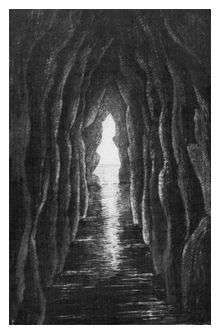Rathlin Island massacre
The Rathlin Island massacre took place on Rathlin Island, off the coast of Ireland on 26 July 1575,[1] when more than 600 Scots and Irish were killed.

Sanctuary attacked
Rathlin Island was used as a sanctuary because of its natural defences and rocky shores; when the wind blew from the west, in earlier times it was almost impossible to land.[2] It was also respected as a hiding place, as it was the one-time abode of St. Columba.[2] Installing themselves in Rathlin Castle, the MacDonnells of Antrim made Rathlin their base for resistance to the Enterprise of Ulster. Their military leader, Sorley Boy MacDonnell (Scottish Gaelic: Somhairle Buidhe Mac Domhnaill) and other Scots had thought it prudent to send their wives, children, elderly, and sick to Rathlin Island for safety.[2]
Acting on the instructions of Sir Henry Sidney and the Earl of Essex, Sir Francis Drake and Sir John Norreys took the castle by storm. Drake used two cannons to batter the castle and when the walls gave in, Norreys ordered direct attack on 25 July, and the Garrison surrendered.[3] Norreys set the terms of surrender,[3] whereupon the constable, his family, and one of the hostages were given safe passage and all other defending soldiers were killed, and on 26 July 1575, Norreys' forces hunted the old, sick, very young and women who were hiding in the caves.[3] Despite the surrender, they killed all the 200 defenders and more than 400 civilian men, women and children. Drake was also charged with the task of preventing any Scottish reinforcement vessels reaching the Island.[4]
The entire family of Sorley Boy MacDonnell perished in the massacre.[3] Essex, who ordered the killings, boasted in a letter to Francis Walsingham, the Queen's secretary and spymaster, that Sorley Boy MacDonnell watched the massacre from the mainland helplessly and was "like to run mad from sorrow".[5]
Aftermath
Norreys stayed on the island and tried to rebuild the walls of the castle so that the English might use the structure as a fortress. As Drake was not paid to defend the island, he departed with his ships. Norreys realised that it was not possible to defend the island without intercepting Scottish galleys and he returned to Carrickfergus in September 1575.[5]
See also
- List of massacres in Ireland
- Betrayal of Clannabuidhe
- Massacre of Mullaghmast
References
- Hadfield, Andrew; Maley, Willy (1993). Bradshaw, Brendan (ed.). Representing Ireland: Literature and the Origins of Conflict, 1534-1660 (1. publ. ed.). Cambridge University Press. ISBN 9780521416344.
- "Rathlin Island". www.booksulster.com. Retrieved 20 January 2018.
- Nolan, John S. (1 January 1997). Sir John Norreys and the Elizabethan Military World. University of Exeter Press. ISBN 9780859895484.
- Kelsey, Harry (1998). Sir Francis Drake: The Queen's Pirate. Yale University Press. pp. 71-74. ISBN 0300071825.
- Sugden, John (1990). Sir Francis Drake. Barrie & Jenkins. ISBN 9780712620383.